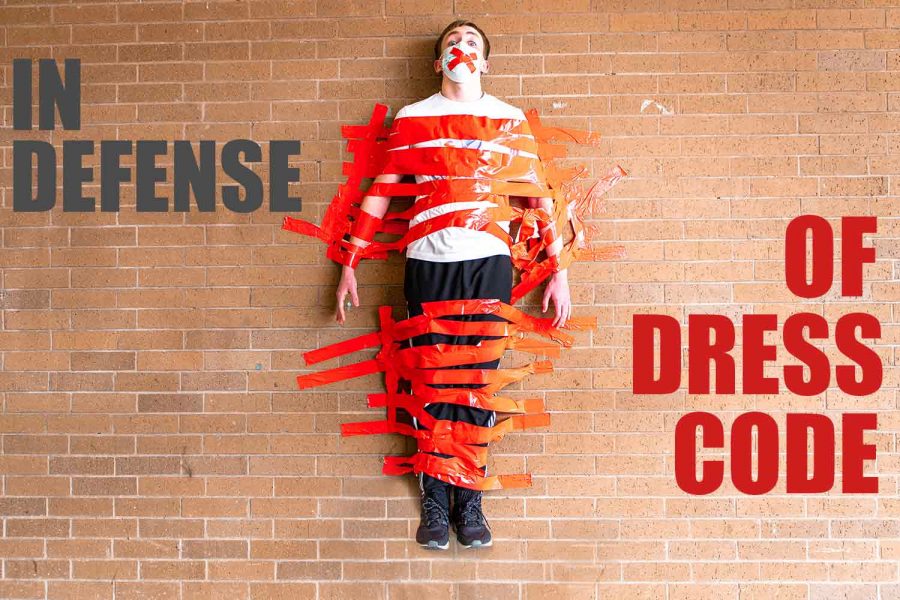Defending dress code
Criticism against dress code countered by administration
Photo by Caden Rainwater
It’s easy to understand criticism of the dress code; the policy which was designed to maintain an optimal learning environment pulls students away from class and lands them in trouble that, in a student’s mind, is all for naught.
November 2, 2020
You’re listening to your first period teacher, doing your very best to pay attention. Then, in a moment’s notice, class screeches to a halt. You will be removed from class after being reported for violating Texas High’s dress code. Whether it takes tape gripping every hole in your new jeans or a trip taken by a parent to bring you more ‘appropriate’ attire, the school will see this problem solved.
It’s easy to understand criticism of the dress code; the policy which was designed to maintain an optimal learning environment pulls students away from class and lands them in trouble that, in a student’s mind, is all for naught. Is it really worth it to force a change in my clothes? How can these adult teachers and administrators govern the fashion laws of teens?
While belonging to a different generation than today’s students, these teachers and administrators see particular merit to enforcing a dress code on their younger counterparts. Keeping learning front of mind and distracting outfits out, protecting the safety of students, and preparing students for the workplace are all reasons cited in defending the dress code. Associate principal Richard Stahl was quick to mention security concerns as one of the main objectives the dress code should achieve.
“Safety is always paramount at any school you go to,” Stahl said. “The reason why we don’t have hats, hoodies, things like that is because in case there’s an intruder, or someone else, we need to be able to identify everybody so we can tell if they’re supposed to be on campus.”
Having clearly visible faces in view of security cameras is necessary in investigating many incidents. Stahl explains a hypothetical scenario in which a hoodie or other prohibited clothing item would prevent finding a potential culprit.
“If, say, a friend of yours lost their cell phone and someone with a Texas Rangers shirt walked up near them, we would be able to tell from the shirt,” Stahl said. “But, there could be four or five with that shirt that day, but if they have their hat and hoodie off, we can identify them [easily].”
As students know, much of the opposition to the dress code goes further than banning clothing preventing identification, and administrators are aware of this. Concerns over the dress code potentially being stricter on young women, to an unfair degree, are quickly dismissed by the school.
“I don’t believe [the codes are sexist],” Stahl said. “I have heard that [criticism], the majority of it being because holes in their jeans can’t be too high. I think the answer is: don’t have the holes in your jeans too high. We’ve gone with the fingertip method for years and years and it has worked well for a lot of schools.”
While the code might not be especially unfair, it’s been said the enforcement is. Stahl is quick to point out that this isn’t the case at all.
“We’ve got some administrators that point out the ladies, and some, who point out the guys,” Stahl said. “The guys get it just as much. If we pulled up the [records], it would probably be a lot closer to 50/50 than most realize because of things like sagging, and we’ve been doing pretty good with that.”
It’s clear what is and isn’t allowed. Students have always been able to visit the “Dress and Grooming” section of the student handbook to see what is prohibited. However, much of the criticism comes from what rules are enforced, and what rules included in the handbook are often overlooked. “Any hairstyle or hair color that is distracting” is said to not be allowed, but any student can tell you this standard isn’t enforced.
“[Colors and hairstyles] that are distracting are not [enforced],” Stahl said. “It’s become the norm, and it’s become acceptable. Do you really think it’s distracting?”
Stahl doesn’t. What is undoubtedly distracting however, is pulling one out of class for violating the dress code. The administration views this as a necessary action.
“I think it would be distracting [to be ‘dress-coded’],” Stahl said. “I think, that’s something that students should think about when they get dressed in the morning because, sometimes what you’re wearing can distract the class too.”
What constitutes distracting, and what constitutes normal in a culture where fashion trends change every season? In students’ minds the long-held dress code might have some updating to do.
“I totally believe things change with the times in what society accepts,” Stahl said. “I went to seniors and juniors a couple of years ago and asked for their opinions on what they think is a proper dress code. If someone brings us an idea and can back it up with some reasons, I’d be willing to listen.”
Consider the reasoning behind the school’s dress code and the willingness of administrators to listen to complaints, and students will likely realize there is much more merit to the system of the school dress code than they often see. There’s certainly worse alternatives for the student body.
“Uniforms are an option,” Stahl said. “Everybody could wear the same thing, but we’d lose our individuality. We’re just trying to prepare [students] for college or the business world, things like that down the road.”
















